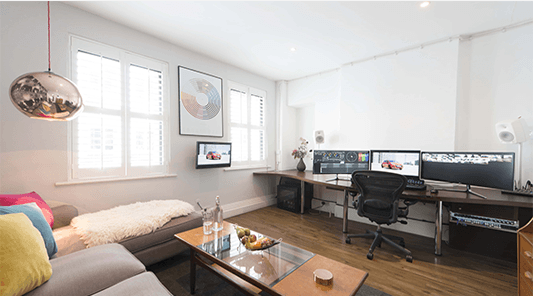Fifty Fifty


The StorNext install went really smoothly. There was no down time in any of our working environments—none at all—and the day after the install was complete, we were migrating media on to the storage and working with it straight away. It couldn’t have been better.


Leading London Post-Production House Scales Up for 4K with Quantum StorNext
A combination of rapid growth and new 4K work meant that London-based post house Fifty Fifty was outgrowing its storage systems. The solution was adding an Xcellis® Foundation system. StorNext® empowers the company do all 4K finishing at high speed from shared storage, and fully automates archiving and retrieval.
London-based Fifty Fifty Post Production is an independently owned post house based in a 1740-built Georgian townhouse in the heart of Soho. Through almost a decade and a half of work, the company has earned a reputation for creativity and reliability. An expansion in the summer of 2017, along with an increase in projects in 4K and 6K formats, prompted the company to look at upgrading its infrastructure and workflows.
Looking for an Upgrade for Performance and Automation
In its old system, Fifty Fifty used Avid ISIS 5500 storage for online work, some NAS-connected nearline disk and an LTO-5 library for archiving. The system had worked well for traditional broadcast HD workflows but struggled to handle 4K work. As the team looked for a new solution, they placed a priority on increasing performance to handle all the higher resolution work in house, and on automating the archiving function to reduce administration overhead and make it faster and easier to access existing content.
Search Leads to Quantum StorNext
Alex Meade, Operations Director at Fifty Fifty, who explored all the market alternatives, explains. “We were looking for a storage solution we could use as a tool across the business—where the production team as well as the technical team could have direct access to content—and that from a creative application point of view was vendor-agnostic.”
Meade found exactly what he wanted in the Quantum Xcellis Foundation storage solution. This appliance-based system includes the StorNext 6 file system, an Xcellis workflow storage system with 192 TB of high-performance RAID and a Quantum Scalar i3 LTO-7 library as an archive. Fifty Fifty’s Quantum solution also includes StorNext Storage Manager software, which automatically makes copies of files and moves content between disk and tape to create an active archive.
New System Fits in Easily with Existing Storage
The new StorNext and Xcellis solution operates side-by-side with the company’s existing storage system. “The Quantum StorNext is connected to our Baselight grading suite and also our Flame and Symphony online suites—all with a 10 GB connection—so they can share media,” Meade says. “So, for 4K finishing, we’re not moving around terabytes of media within stand-alone islands of storage any more. This allows us the versatility and the speed to deliver fast turn-around projects for our customers.”
Choice Based on Technology and Brand
Meade explains that the selection of StorNext was based both on the strength of the technology and the expertise of Quantum as a supplier: “We’re very confident in the robustness of the storage. And just as important, Quantum has a very good reputation that made them instantly attractive.
A Perfect Installation
Installing the new system and making it work in the existing Fifty Fifty environment was seamless. “The install by Quantum was really well managed, and we worked closely with them and our supplier, Digital Garage. They helped us with the advance planning to make sure all the infrastructure was in place and ready for the integration. It couldn’t have been better.”
Future Will Bring More and More Data
“The key driver for us was working towards a 4K future,” Meade continues. “StorNext gives us the performance to run all of our 4K finishing suites centrally from our shared storage, a tremendous improvement over our old system that is allowing us to finish work much faster.”
StorNext’s easy scalability was also important for Fifty Fifty. “We’re well aware that storage gets used up no matter how good you are at media management and how well you plan. There’s always a point where you need more storage, and it was important to us we had a scalable piece of hardware that could also increase speed when we need it to for any future requirements in this ever-changing media environment.”


